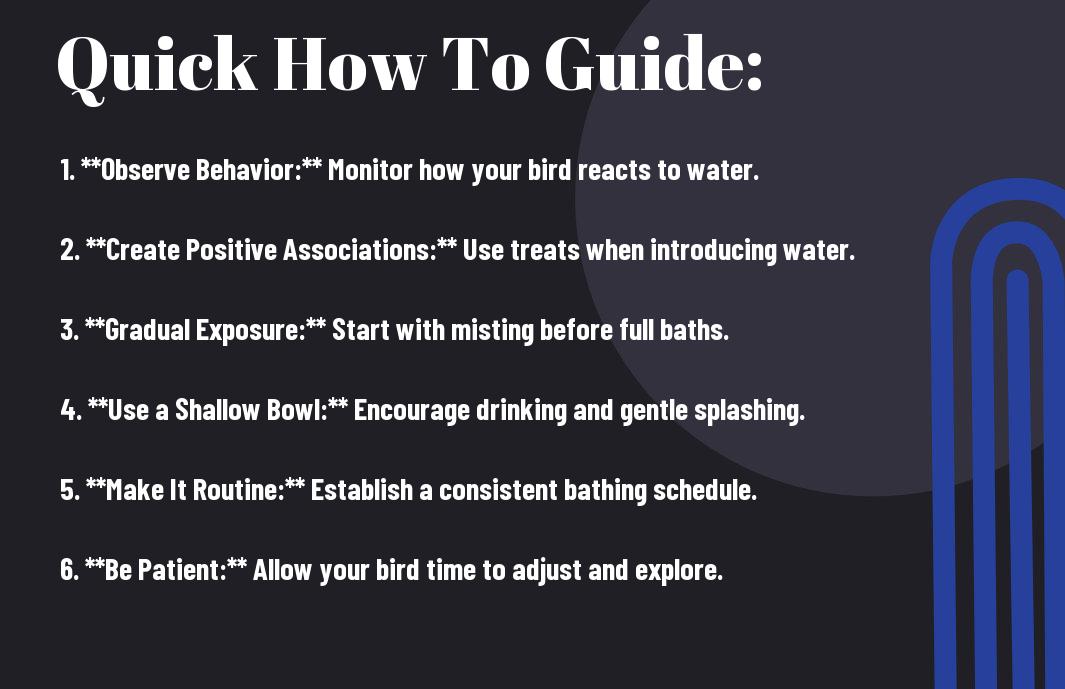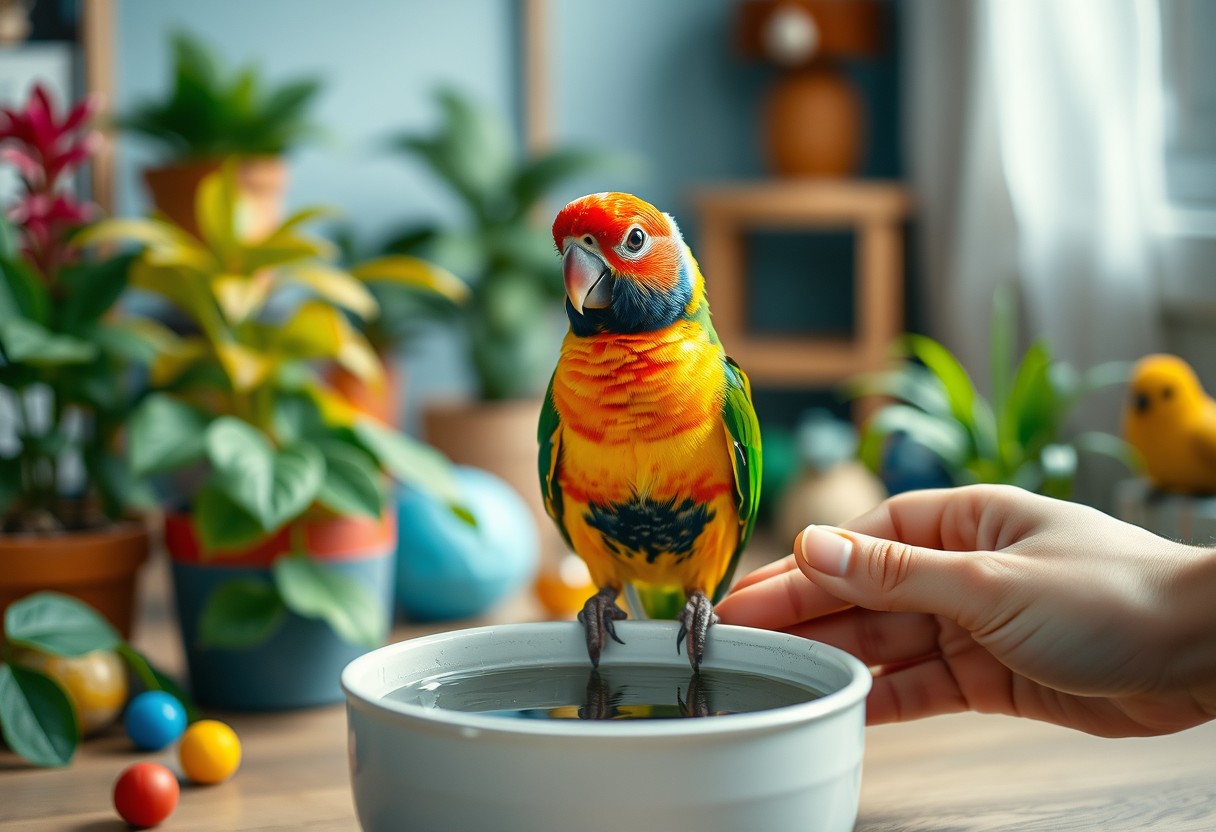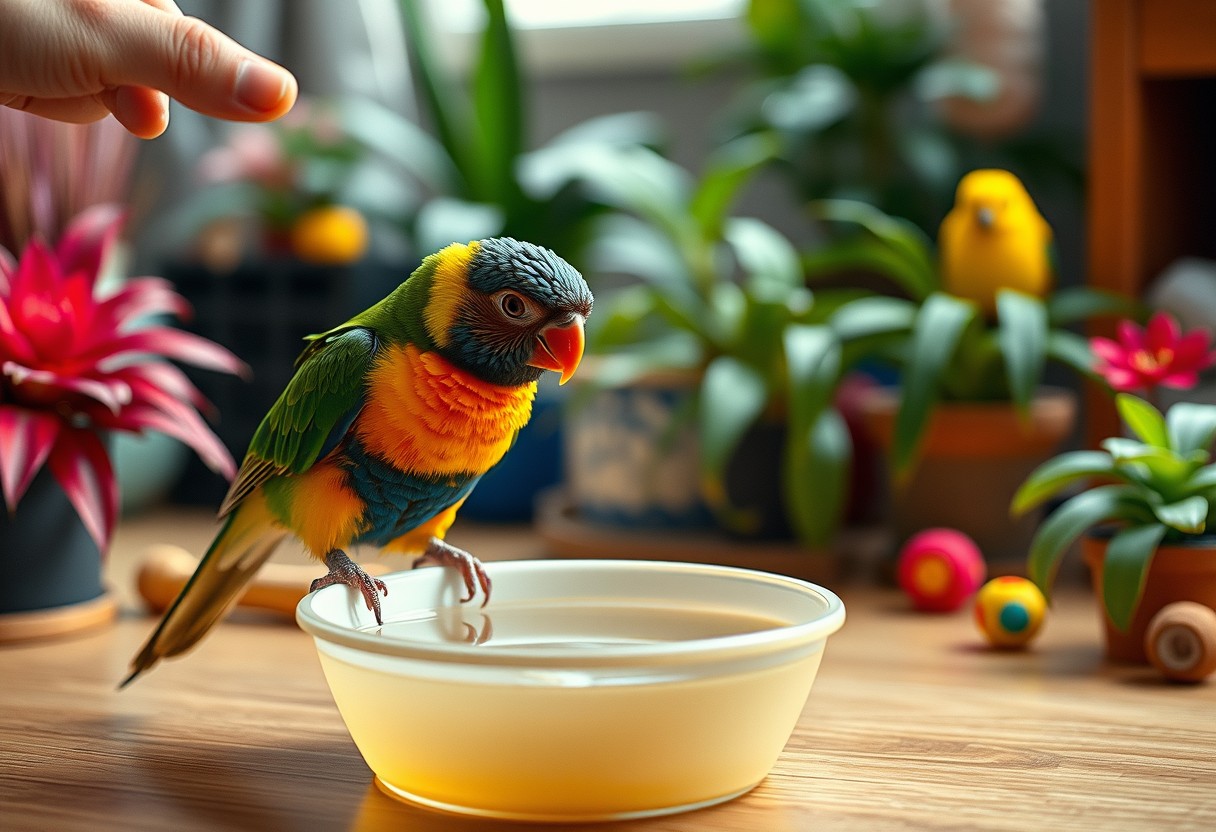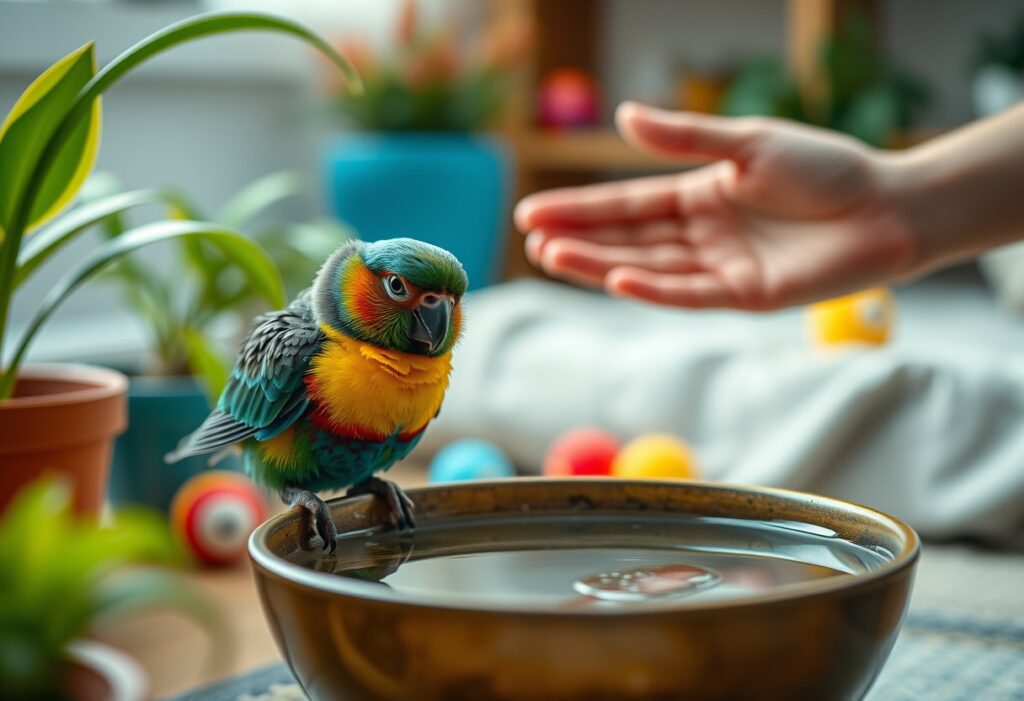Water can be a daunting experience for birds, especially for those with a strong aversion to it. Understanding your bird’s fear is crucial to fostering a comfortable environment. You can gradually introduce water through gentle methods such as misting or offering shallow dishes. Your patience and consistency will help build trust, leading to a more positive association with bathing. Recall, never force your bird into water; instead, allow it to explore at its own pace for a stress-free experience.

Understanding Fear of Water
While it can be frustrating to deal with a bird that is afraid of water, it’s crucial to understand the root causes of this fear. Many birds are instinctively cautious around water, which can be attributed to their natural behaviors and environmental adaptations. For instance, in the wild, water can pose various dangers, such as predators lurking near water sources or the risk of drowning. Moreover, some birds may have had negative experiences in water during their early development, solidifying a lasting fear that can be challenging to overcome.
Common Reasons Birds Fear Water
While the fear of water in birds is quite common, the reasons behind it can vary widely. One prevalent issue is a lack of early exposure; if young birds do not encounter water in a safe and positive environment, they may grow up associating it with danger. Additionally, birds that have experienced traumatic events, such as falling into water or having a sudden splash occur, can develop a long-lasting anxiety towards it.
Factors Influencing Water Fear
Influencing your bird’s reaction to water can be complex, as various factors contribute to their overall *fear level*. For example, the *species* of the bird plays a significant role; some birds, like parrots, may be more naturally inclined to enjoy water play, while others, such as cockatiels, might feel threatened by it. Environmental elements can also impact their perception of water. If their living space has an aggressive or frightening atmosphere when water is introduced, they may develop even stronger aversions.
- Species of the bird
- Environmental conditions
- Previous experiences
This understanding is critical for you as an owner working to manage your bird’s fear of water. You might also consider issues like the age of your bird and the potential stressors in their surroundings. A young bird might adapt more easily than an older, fully formed individual that has developed a long-standing aversion. Pay special attention to how you introduce water to your bird’s environment, as a gentle and gradual approach can make all the difference.
- Age
- Stressors in the environment
- Gradual introduction
Knowing the underlying factors that contribute to your bird’s fear of water can guide you in creating a more comforting experience. By being aware of their unique needs, you will be better equipped to help them overcome their apprehension and encourage healthy behaviors towards water.
Preparing for Water Exposure
Now, as you start the journey of helping your bird become more comfortable with water, preparation is imperative. Taking the time to establish a safe and friendly environment for your feathered friend will significantly increase your chances of a successful water introduction. Being mindful of their feelings and behaviors will help you create a positive experience that they will remember for future water encounters.
Choosing the Right Environment
Even though your bird is afraid of water, a calm and secure setting can make all the difference. Choose a location that is free from loud noises, such as pets or children, which might heighten your bird’s anxiety. Consider an area that is well-lit but not direct sunlight to avoid overheating, as birds can easily become stressed in extreme temperatures. Setting the mood to be as peaceful as possible will help your bird feel more at ease as you introduce water.
Additionally, try to keep the area familiar. If possible, use a space that your bird already feels comfortable in, like their usual play area or a spot where they often spend time. You may also want to incorporate some of their favorite toys or perches nearby to create a welcoming atmosphere that encourages exploration and, ultimately, acceptance of water.
Timing: When to Introduce Water
Little by little, you will need to approach the timing of water exposure carefully. It is crucial to pick a moment when your bird is feeling relaxed and secure rather than anxious or excited. Early morning or late afternoon, when birds are naturally more subdued, can be ideal times to begin this process. Avoid introducing water after any stressful events, such as trips to the vet or changes in their environment, as this could further complicate their feelings towards water.
Water exposure can be a gradual progression. You may want to start with brief introductions, reviewing their behavior after each experience to ascertain their comfort level. Be patient, as rushing into water exposure can reinforce fears rather than ease them.
Selecting Appropriate Tools and Toys
Little steps matter in creating a positive water experience for your bird. Opt for tools that are non-threatening and enticing. For instance, consider using small, shallow bowls or a gentle misting spray rather than a deep bath. A spritz bottle may mimic the natural rain showers birds often enjoy while still allowing them to acclimate on their terms. Offering playful tools like water-safe toys can help make the experience feel more like play and less like a chore.
Choosing the right tools can transform water exposure into a positive activity. Look for water-related items that are brightly colored or feature interesting textures, as these can draw your bird’s attention and spark curiosity. Avoid any harsh chemicals or toys that could cause harm, ensuring everything in their water play area is safe.

Manage your bird’s fear of water with patience and understanding. Birds often associate water with negative experiences, so it’s imperative to create a positive environment for them. Start by introducing water slowly, using shallow dishes and gentle misting to ease their anxiety. Recall, never force your bird into water, as this can intensify their fear. With time and consistent positive reinforcement, you can help your avian friend develop a more relaxed attitude towards water, improving both hygiene and overall well-being.

Tips for Ongoing Water Management
Keep your bird’s hydration and cleaning routine consistent to help alleviate their fear of water. This gradual approach allows your feathered friend to become accustomed to water without feeling overwhelmed. To effectively manage your bird’s aversion to water, consider the following:
- Introduce water gradually through mist spraying.
- Utilize a shallow bath to allow for comfortable splashing.
- Maintain a calming environment during water interaction.
- Ensure regular appointments with an avian veterinarian for health checks.
- Be patient and celebrate small victories as your bird adapts.
Maintaining a Routine
For your bird to become comfortable with water, establishing a consistent routine is vital. Incorporate bathing sessions into your bird’s daily activities, allowing them to feel safe during these times. Whether it’s a gentle misting or a bath, regular exposure can help them adjust gradually. Remember to keep the bathing environment calm and inviting, reinforcing positive associations with water.
For optimal results, try to schedule these sessions at the same time each day. This predictability can reduce anxiety as your bird begins to anticipate bath time. Observing their comfort level can inform you whether to increase or decrease the intensity of the exposure, ensuring that your bird remains relaxed and receptive during these routines.
Monitoring Behavior and Adjusting Approaches
While you work on your bird’s water management, it’s crucial to keep an eye on their behavior. Observe how they react to each water interaction and note any signs of stress or relaxation. If your bird shows visible discomfort, consider altering your techniques, such as reducing water temperature or offering warmer environments. This adaptability in your approach can significantly enhance their comfort and confidence.
While you continue monitoring your bird’s progress, make sure to document any behavioral changes. Adjusting your approach based on these observations not only helps in pinpointing what works best but also fosters a trusting relationship between you and your bird. Remember that every bird is unique, and recognizing their individual preferences will pave the way for successful water management.
The more you adapt to your bird’s needs, the more successful your efforts will be in building their confidence around water. Create a journal to note what techniques seem to work and which do not, and remain flexible in your methods.
Seeking Professional Help if Needed
Help is always available if you find your bird continues to struggle with water-related issues. Consulting an avian behaviorist or veterinarian who specializes in birds can provide tailored strategies to help your pet overcome their fear. These professionals can also determine if any underlying health issues may be contributing to your bird’s aversion to water.
Help is vital especially if your bird displays excessive stress or begins to develop behavioral problems tied to their water fears. Combining their expertise with your observations can create a holistic plan that emphasizes both health and comfort, making water management a more achievable goal for you both.
Maintaining a proactive approach in seeking assistance ensures that your bird receives the best chance to socialize with water in a healthy way. The right support can make all the difference in your bird’s hydration, cleaning habits, and overall emotional well-being. Knowing that you’re equipped with the right tools and support can bring peace of mind as you navigate this sensitive aspect of your bird’s care.
Final Words
Presently, managing a bird that is afraid of water requires patience and understanding of your pet’s unique behaviors and fears. Start by creating a safe and tranquil environment that promotes comfort during water-related activities. Gradually introduce your bird to water – whether it’s through gentle misting, shallow baths, or allowing them to observe other birds enjoying water. It’s crucial to ensure that these interactions are positive, always using treats or praise to reinforce the idea that water can be enjoyable. Recall, every bird is different, and they may take their time adapting to this new experience.
Furthermore, be patient and observant throughout the process. If your bird shows signs of stress or fear, take a step back and try again later. Using toys that mimic water play, such as misting from a spray bottle or offering a soaking wet leafy vegetable, can also help your bird build a more positive association with water. Ultimately, the goal is to create a stress-free environment that encourages exploration and comfort with water, helping your feathered friend to thrive. By understanding their needs and their limits, you can help your bird gradually overcome its fears while fostering a trusting relationship with you.
FAQ
Q: What are the signs that my bird is afraid of water?
A: Birds that are afraid of water may exhibit various signs, such as avoiding baths, showing stress or anxiety when water is present, puffing up their feathers, vocalizing loudly, or attempting to fly away when approached with water-related activities. It’s important to observe their body language carefully; signs of fear can include wide eyes, fluffed feathers, and rapid breathing. Recognizing these signs is the first step in addressing their phobia.
Q: How can I gradually introduce my bird to water without causing panic?
A: Gradual exposure is key to helping your bird become more comfortable with water. Start by placing a shallow dish of water near its perch, allowing your bird to observe it without pressure. You can also use misting with a spray bottle at a distance, ensuring it’s a fine mist. Over time, decrease the distance gradually as your bird becomes more curious. Be patient and never force your bird into water; instead, reward progress with treats and praise to create positive associations.
Q: What should I do if my bird becomes agitated or scared during water-related activities?
A: If your bird shows signs of agitation during water activities, immediately stop and remove the water source, allowing your bird to calm down. It’s crucial to create a safe and stress-free environment. You can also provide a quiet space where they can retreat. Always use a gentle voice and encourage them with calm body language. It might take time, but consistently creating positive experiences will help your bird build confidence over time. Seeking advice from a veterinarian or avian behaviorist can also provide additional strategies tailored to your bird’s specific needs.











